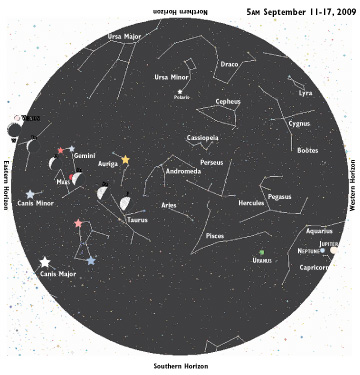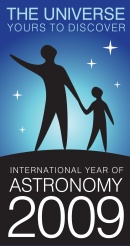
Volume XVII, Issue 37 # September 10 - September 16, 2009 |
 |
 |
 Sky Watch
Sky Watch
by J. Alex Knoll
Early Morning Lights in Summer’s Twilight
Soon enough they’ll be fixtures of winter’s night sky
Friday’s third-quarter moon rises around 11:30pm in the northeast, then appears in the same spot more than an hour later each night after. The moon crests the horizon a half-hour after midnight Saturday/Sunday, with Mars trailing by five degrees. The next day the moon trails Mars by about 10 degrees. Come sunrise, near 6:45, they are high in the east.
 Several years ago, Mars passed its nearest to Earth in recorded history, and it shone like a celestial beacon. Now, however, the red planet is far from earth and shines at barely first magnitude. Nevertheless, rumors persist on the Internet that Mars will soon appear so large as to rival the full moon. No such luck.
Several years ago, Mars passed its nearest to Earth in recorded history, and it shone like a celestial beacon. Now, however, the red planet is far from earth and shines at barely first magnitude. Nevertheless, rumors persist on the Internet that Mars will soon appear so large as to rival the full moon. No such luck.
In fact, Mars is surrounded by stars equally bright as well as a few of the night sky’s standouts.
A dozen degrees to the north of Mars shine Castor and Pollux, the Gemini twins. Orange-hued Pollux is a bit brighter than white Castor, but both appear on par with Mars.
To the south of Mars is the familiar shape of Orion. The red-giant Betelgeuse, 11th-brightest star, marks the hunter’s shoulder. Farther to the south, at Orion’s heel, shines the blue-white super-giant Rigel, at zero magnitude the seventh brightest star.
Far overhead of Mars to the west shines golden Capella in the constellation Auriga. At zero magnitude, Capella is the sixth brightest star.
Twenty degrees to the east of Mars punctuating Canis Minor is zero-magnitude Procyon, eighth brightest star. But all these pale next to Sirius, the big dog of Canis Major. At a scorching magnitude of negative 1.42, Sirius is the brightest star of all, twice as bright as any other.
Illustration: © Copyright 1925 M.C. Escher/Cordon Art-Baarn-Holland; Graphics: © Copyright 2009 Pacific Publishers. Reprinted by permission from the Tidelog graphic almanac. Bound copies of the annual Tidelog for Chesapeake Bay are $14.95 ppd. from Pacific Publishers, Box 480, Bolinas, CA 94924. Phone 415-868-2909. Weather affects tides. This information is believed to be reliable but no guarantee of accuracy is made by Bay Weekly or Pacific Publishers. The actual layout of Tidelog differs from that used in Bay Weekly. Tidelog graphics are repositioned to reflect Bay Weekly’s distribution cycle.Tides are based on National Oceanic and Atmospheric Administration and are positioned to coincide with high and low tides of Tidelog.
